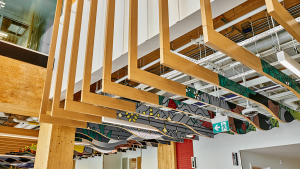Canada’s green building industry is a world leader in the sector and is taking great strides in developing new technologies, strategies and standards — but lack of co-ordination remains a significant problem, experts lamented at a recent conference devoted to the sector.
It was a refrain heard throughout the Canada Green Building Council’s Building Lasting Change conference held in Toronto June 5 and 6, but there were ample indications the players are willing to change course.
Brad Carr, CEO of Mattamy Homes Canada, addressed a luncheon audience to help launch the Responsible Buildings Pact, a new cross-industry agreement aimed at increasing the use of low carbon materials in the built environment.
Green building should be a team sport, said Carr.
“This is not a space where we need to compete with each other. This is a space where we must collaborate together,” he said.
“Our common enemy is the climate, and it’s not an enemy. It’s something we want to protect and the best way to do that is as a collective.”
Starts with concrete
The pact is being launched by the Climate Smart Buildings Alliance (CSBA), a joint project between EllisDon, RBC and Mattamy. So far 23 firms have signed on.
By joining the pact, companies will make three commitments:
- remaining educated on lower carbon materials.
- establishing an internal process to consistently evaluate whether lower carbon materials or design strategies can be used.
- reporting publicly on the results of their evaluation process and evaluations and identifying opportunities to use lower carbon materials.
The first year of the pact, June 2024 to May 2025, will be a pilot year, with signatories focusing on concrete.
In 2025, a more formal agreement will be put in place to expand the pact’s requirements for other materials, including steel, cladding, insulation and finishes.
“The technology exists now to potentially reduce the embodied portion of those emissions by approximately 40 per cent,” said Jody Becker, EllisDon COO. “We must create a sustainability culture across our industry in a similar way as our approach to safety, where doing the right thing isn’t competitive, it’s a collaborative mandate.”
The CSBA presentation was preceded by an address by CAGBC CEO Thomas Mueller. Mueller highlighted numerous successes and initiatives of the council in the past year but also took note of the collaboration gap.
“When we talk to each other we have great conversations, but we need to also reach other people in the industry, because most of the people in the industry don’t know what to do,” said Mueller. “This is really the challenge, to collaborate and to reach other audiences that we can bring the argument to, that zero-carbon buildings, low-carbon buildings, create great value over a long period of time for the owners and for the occupants.”
To help achieve Canada‘s goal of reducing GHG emissions 40 to 45 per cent by 2030, the CAGBC is focusing on large commercial and institutional buildings, representing over 40 per cent of the sector emissions.
Mueller: five focuses
Mueller said builders should have five focuses: collaboration; jointly identifying knowledge gaps; defining training and capacity-building priorities; strengthening existing networks to share knowledge; and providing guidance, tools and resources to build capacity.
The CAGBC has been working to build strong partnerships and strategic alliances, Mueller said.
Among those already established are alliances with the Canada Infrastructure Bank, the realtor alliance REALPAC, Infrastructure Canada, Green Business Certification, World Green Building Council and the USGBC. Emerging partnerships include the CSBA, the Business Development Bank of Canada and R-Labs.
“The result of those alliances will be “meaningful actions, meaningful programs and tangible outcomes,” said Mueller.
Canada needs to spend $150 billion annually to decarbonize the country’s economy, Mueller said.
“That is no small amount of money,” he said.
There is a proliferation of new building codes and standards in jurisdictions nationally and globally but they are fragmented – for green builders, that is not a great value proposition, Mueller said.
More alignment and co-operation is important, he said.
In sum, Mueller said, green building is moving from a “nice to have” to guiding real estate investment decisions. The global and national government policy agenda and funding must align on buildings as a climate solution.
“The industry has an opportunity to provide market-based solutions but more co-ordination is needed,” he said.
Follow the author on Twitter @DonWall_DCN.











Recent Comments